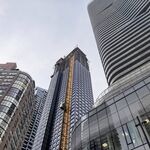'Shame on Canada'
Architect slams government's handling of portrait gallery
Maria Cook, The Ottawa Citizen
Published: Thursday, March 13, 2008
Major cultural institutions "should not be victims of party politics," says the high-profile British architect who designed plans for the Portrait Gallery of Canada at the doomed Wellington Street site.
"Shame on Canada and shame on the present government for reversing the previous government's decision," Edward Jones wrote in an e-mail to the Citizen that criticizes the federal government's controversial bidding process for a new location for the gallery.
"A wealthy country like Canada should pay for its own institutions without subsidy from the private sector," he says.
After cancelling the project begun by the Liberal government, the Conservative government last year unsuccessfully tried to place the gallery in Calgary. Then, last November, it announced a competition inviting private sponsors in nine cities to bid on the national institution.
In his e-mail, Mr. Jones noted that the Royal Opera House redevelopment in London was introduced by Margaret Thatcher and completed by Tony Blair.
Prior to the portrait gallery's cancellation, the federal government had spent at least $9 million and some renovations had taken place, although construction of the extension had not yet started.
"We won an international competition for this project," Mr. Jones says. "We made countless transatlantic flights; we attended many, many meetings with (Canadian Heritage) and the National Capital Commission.
"In the spirit of goodwill, we made a very large financial loss on this project -- the result, working with Public Works and the director and staff of the Portrait Gallery of Canada was in our, and the opinion of others, a fine, contemporary contribution to the architecture of Wellington Street."
Now, Ottawa is competing with Vancouver, Halifax, Quebec City, Montreal, Toronto, Winnipeg, Edmonton and Calgary for the right to have the gallery, which is part of Library and Archives Canada.
Mr. Jones is the designer of the elegant Ondaatje Wing at the National Portrait Gallery in London, which won rave reviews. His firm is responsible for several significant cultural projects in Britain, including the Henry Moore Institute in Leeds and London's Royal Opera House. He also designed the dramatic Mississauga City Hall when he worked in Toronto during the 1980s.
Mr. Jones was selected in 2003 to renovate the former United States embassy at 100 Wellington St., across from Parliament Hill, and to design an addition in the parking lot west of the building. His team included Stephen Teeple, an award-winning Toronto architect, and Ottawa architect David Cole. A selection committee considered proposals from six other joint ventures.
Bids for the new gallery location are to be submitted by April 16. And the process is far different from any undertaken to create a national institution.
In the normal course of events on a public project, there is an architectural competition and the selection process is geared to finding people with demonstrated design skills and relevant experience -- such as Mr. Jones. Developers are not involved because the Crown typically owns the land and the project is managed by Public Works.
This time, design is not even on the list of criteria. Under the competition terms, developers do not have to submit a design or come forward with an architectural/engineering team. The proposals will be judged on four criteria: a "prominent, accessible and suitable location," developer expertise and financial capability, financial support from the private sector and community, and the financial deal on offer.
In other words, the government will select a city, site and developer without a requirement for a design team with credibility. It is seeking an arrangement with a developer entirely on the basis of a financial and site proposal.
It is the same process used in procuring leased office space.
Ottawa's submission comes from Claridge Homes.
Neil Malhotra, of Claridge, said he believed it would be a fair selection process and that the government wants a building of good quality.
"It's not going to the cheapest bidder," he said. "The government doesn't want it in a suburban (shopping) power centre. We wouldn't go through the effort if there wasn't some opportunity for Ottawa."
Claridge has filed an application with the city for two 26-storey residential towers with a gallery designed by well-respected Montreal architect Dan Hanganu. It would be built in what is now a parking lot bounded by Lisgar, Nepean and Metcalfe streets in the heart of downtown. Although Claridge didn't have to produce a design, it has allowed the public to see a preliminary image that shows an origami-shaped gallery at the base of two slim towers.
In Mr. Jones's view, the "profitable highrise building sits patronizingly over what I assume is the Portrait Gallery of Canada sitting apprehensively below."
At a public meeting last week, there was opposition to the height and scale of the condo project. Some people said they want the rezoning for additional height to be conditional on winning the competition; if Ottawa loses, they did not want to be left with tall towers and no gallery. The zoning report is expected to come to city council on April 9.
Ralph Wiesbrock, regional director of the Royal Architectural Institute of Canada, says it is shocking that the federal government would exclude design and designers from the proposal requirements.
"It is hard to fathom how a project that will house a major component of our country's history could be developed without any attention to the quality of the building or space that it is housed in," he says.
© The Ottawa Citizen 2008




